-
PDF
- Split View
-
Views
-
Cite
Cite
S. Paiano, M. Landoni, R. Falomo, R. Scarpa, A. Treves, On the redshift of the very high-energy gamma-ray BL Lac object S2 0109+22, Monthly Notices of the Royal Astronomical Society, Volume 458, Issue 3, 21 May 2016, Pages 2836–2839, https://doi.org/10.1093/mnras/stw472
Close - Share Icon Share
Abstract
The determination of the redshift of extragalactic gamma-ray sources is of fundamental importance for the interpretation of their emission models and extragalactic population studies, active galactic nuclei classification schemes, and to study the interaction with the extragalactic background light. Here we focus on the BL Lac S2 0109+22, recently detected at very high energies. We obtained a high signal-to-noise optical spectrum at Gran Telescopio Canarias for the source over the spectral range 4000–10 000 Å, to search for spectral features of the host galaxy and/or of the nuclear source and it was compared with previous observations in order to confirm and/or dispute its redshift determination. We find the S2 0109+22 optical spectrum is well represented by a power-law continuum without any absorption or emission feature of equivalent width >0.1 Å. Based on the new optical spectrum, we are able to set a redshift lower limit z > 0.35, assuming the source is hosted by a massive elliptical galaxy typical for this class of sources. The redshift z = 0.265 proposed in the literature for this object is most probably referred to a r = 18.3 galaxy at 15 arcsec from S2 0109. This galaxy could belong to a group of faint galaxies located at z ∼ 0.26.
1 INTRODUCTION
Blazars, and in particular the sub-class of the BL Lac objects (Falomo, Pian & Treves 2014), are radio-loud active galactic nuclei (AGN) characterized by a non-thermal, variable and double-bump shape continuum flux spanning from radio to gamma-ray band. Although they are the most numerous extragalactic population in the high-energy (HE) and very high-energy (VHE, E>100 GeV) bands, most of them have unknown or very uncertain redshift. The recognition of the redshift is a key factor to determine the luminosity of these sources, to characterize and build realistic emission models (e.g. Fossati et al. 1998; Böttcher et al. 2013) and to study the absorption of their HE gamma rays emitted with the extragalactic background light (see e.g. Franceschini, Rodighiero & Vaccari 2008; Domínguez et al. 2011).
These considerations motivated several spectroscopic campaigns in order to measure the BL Lac redshift. We are undertaking spectroscopic campaign at the Gran Telescopio Canarias (GTC) to obtain high optical signal-to-noise ratio (SNR) spectra of TeV blazar with unknown or uncertain redshift. First results of this programme were presented in Landoni et al. (2015a) for B0218+357 and Landoni et al. (2015b) for S2 0954+65.
In this paper, we report on spectroscopic observations of the bright (V ∼ 15.5) BL Lac object S2 0109+22 that was recently detected in the VHE gamma-ray band by the MAGIC Cherenkov telescopes (Mirzoyan 2015). The new data allow us to clarify the contrasting literature results about the redshift of this source.
In this work, we assume the following cosmological parameters: H0 = 70 km s−1 Mpc−1, ΩΛ = 0.7, and Ωm = 0.3.
2 S2 0109+22
The source S2 0109+22 (GC 0109+22, TXS 0109+224, RGB J0112+227) is a compact radio object (Davis 1971; Pauliny-Toth et al. 1972) with a 5 GHz flux of 0.78 Jy. The optical identification of the radio source was done with a stellar object of magnitude 15.5 through the optical Palomar Sky Survey (Owen & Mufson 1977). The first spectroscopic observation of S2 0109+22, performed by Wills & Wills (1976), did not find absorption or emission lines, suggesting a BL Lac nature for the object. Subsequent higher quality spectroscopic data1 (Falomo, Scarpa & Bersanelli 1994; Sbarufatti et al. 2006b, 2009; Landoni et al. 2013) confirmed the featureless spectrum. In contrast with the previous results, the optical spectrum obtained by Healey et al. (2008) showed prominent galactic absorption lines at z = 0.265. Curiously another spectrum obtained by Shaw et al. (2009), showed a pure featureless spectrum, but in Shaw et al. (2012) galactic absorption features at z = 0.265 were again present.
From an optical image obtained during a low state (R mag = 16.5) of the source, S2 0109+22 appears unresolved (Falomo 1996, see also Fig. 1). Assuming the nucleus hosted by an elliptical galaxy with MR = −23.5, a lower limit of the redshift of z > 0.4 was proposed. Following R-band images, obtained by Nilsson et al. (2003), also found the object unresolved.
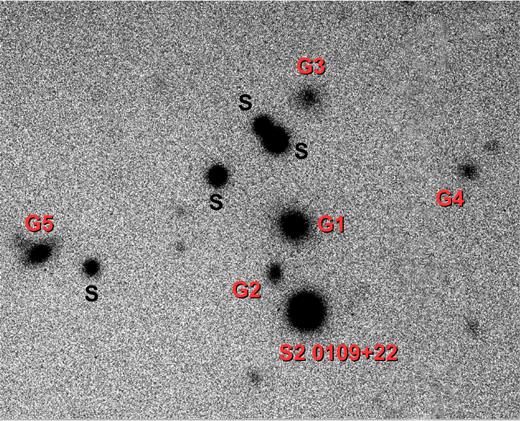
R-band optical image (field = 45 arcsec, north up, east left) obtained at the New Technology Telescope (NTT) for the BL Lac object S2 0109+22 (Falomo 1996). Five galaxies, labelled as G, are present in the field of view of the BL Lac object. The sources flagged as S are classified as star by SDSS.
At the higher frequencies, S2 0109+22 was originally revealed in X-ray bands by Einstein, EXOSAT, ROSAT and Swift, and by Fermi in the gamma-ray band (|$F_{\rm 100\,MeV{\rm -}100\,GeV}$| = 7.78 × 10−11 erg cm−2 s−1; Acero et al. 2015). Finally, the source was also detected in 2015 July at VHE (E>100 GeV) gamma rays by the Major Atmospheric Gamma Imaging Cherenkov Telescopes (MAGIC) telescopes (Mirzoyan 2015) during a high-flux state monitored by Fermi.
From multiwavelength observations, S2 0109+22 is classified as Intermediate BL Lac object by Padovani & Giommi (1995) and Ghisellini et al. (2011) based on the αro–αoX diagram and the position of the synchrotron peak frequency. The strong optical and radio flux variability and Spectral Energy Distribution (SED) properties are consistent with this classification (Ciprini et al. 2003, 2004).
3 OBSERVATIONS AND DATA ANALYSIS
S2 0109+22 was observed on 2015 September 18 with the 10.4 m GTC telescope at the Roque de Los Muchachos, in La Palma. The observations were performed with the spectrograph Optical System for Imaging and low-Intermediate-Resolution Integrated Spectroscopy (OSIRIS) (Cepa et al. 2003) using two grisms, R1000B and R1000R, in order to cover the whole spectral range 4000–10 000 Å, and with a slit width = 1 arcsec yielding a spectral resolution λ/Δλ = 800. For each grism, we obtained three individual exposures of 250 sec in order to perform optimal cleaning of cosmic rays. During the observations the source was of 14.8 in R band as derived by a short exposure acquisition image.
Data reduction was carried out using iraf2 and standard procedures for long slit spectroscopy. The accuracy of the wavelength calibration is 0.1 Å. Flux calibration was obtained from the observations of a spectro-photometric standard star during the same night. The exposures of the two grisms were combined and a final spectrum covering the whole spectral range was merged (see Fig. 2). The SNR per pixel of this spectrum ranges from minimum ∼150 in the blue region to 400 in the central band. The continuum is very well fitted by a power law F(λ) ∝ λα with a spectral index α = −0.56 ± 0.06.
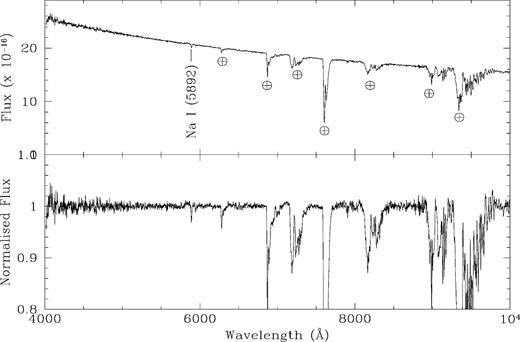
The optical spectrum of the BL Lac object S2 0109+22 obtained with OSIRIS@GTC. Upper panel: flux calibrated spectrum well described by a power law with a spectral index α = −0.56 ± 0.06. Telluric absorption O2 and H20 bands are marked by ⊕. The only visible interstellar absorption line is Na I (5892 Å). Bottom panel: normalized spectrum.
4 RESULTS AND CONCLUSIONS
Our high-quality optical spectral data confirm our previous results that no emission or absorption lines are present in the spectrum of S2 0109+22 (see Fig. 3). The inconsistency with the spectra presented by Healey et al. (2008) and Shaw et al. (2012) could be due to a target mispointing. In fact we note that at ∼15 arcsec, north of the target there is a r = 18.3 galaxy (G1, see Fig. 1). The spectrum of this galaxy, taken from the Sloan Digital Sky Survey (SDSS), is very similar to that presented by Healey et al. (2008) and Shaw et al. (2012) and exhibits absorption lines at z =0.268, that is very close to z =0.265 alleged by these authors (Fig. 4).
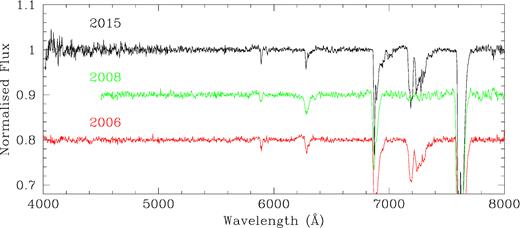
Comparison of the normalized spectra of S2 0109+22 taken in different epochs. From top to bottom: 2015 spectrum (SNR∼650); 2008 spectrum (SNR∼500) (Landoni et al. 2013); 2006 spectrum (SNR∼500) by (Sbarufatti et al. 2009). SNR estimated at 5500 Å for resolution element of 15 Å. The 2008 and 2006 spectra are shifted of 0.1 and 0.2, respectively.
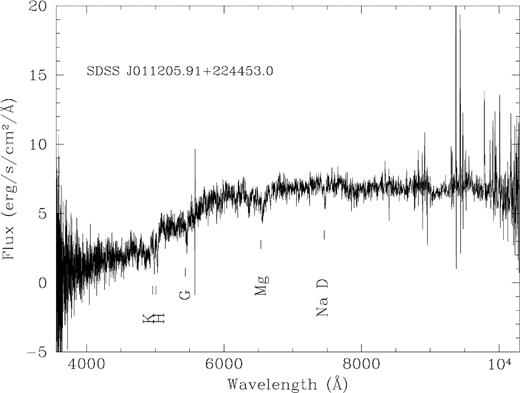
SDSS spectrum of the galaxy G1 (see also Fig. 1) at ∼15 arcsec north of the BL Lac S2 0109+22. Galactic absorption lines at z = 0.268 are easily detected.
We thus conclude that the redshift z = 0.265, attributed to the BL Lac object and present in NASA/IPAC Extragalactic Database and TeVcat data base,3 is wrong as it refers to the close companion galaxy. The redshift of the S2 0109+22 is therefore still unknown. Emission models of the source (e.g. Ghisellini et al. 2011) assuming the wrong redshift should be revised.
Given the featureless spectrum of this source it becomes of interest to set lower limits assuming that the active nucleus is hosted in a typical massive galaxy. From the spectrum obtained in 2006 (see Fig. 3), Sbarufatti et al. (2009) derived a lower limit to the redshift z > 0.25 based on the minimum observable equivalent width (EWmin) under the assumption that the nucleus is hosted by an elliptical galaxy of MR = −22.9 (Sbarufatti et al. 2006a). Following the same procedure applied to the GTC spectrum (better combination between SNR and spectral resolution), we are now able to set a more stringent spectroscopic lower limit of z > 0.35, based on the EWmin = 0.06 Å for absorption features.
To further support this result, we report in Fig. 5 the simulation of the superposition of the observed BL Lac spectrum with an elliptical galaxy template spectrum (Kinney et al. 1996) of MR = −22.9 (Sbarufatti, Treves & Falomo 2005) at three different redshifts (z = 0.1, 0.25 and 0.4). The simulation takes into account the fraction of the galaxy flux lost in the slit (width = 1 arcsec). It turns out that, while for z = 0.1 and 0.25, the signature of the host galaxy is detectable, at z = 0.4, the spectrum remains featureless.
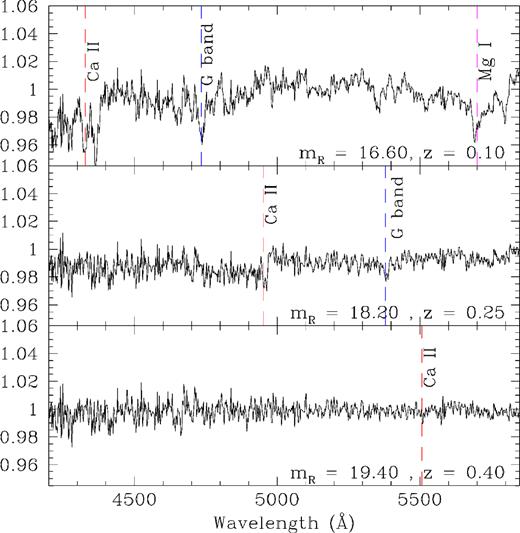
Simulated spectra of S2 0109+22 assuming the contribution of the host galaxy (MR = −22.9) at three different redshifts. Apparent magnitudes, in each panel, represent the values of the host galaxy through the slit. The main absorption features are indicated by vertical dashed lines. Ca ii and G band are still revealed for the case z = 0.10 and 0.25, but not for z = 0.40.
Finally it is worth to note that, in the environment of the galaxy G1 (see Fig. 1), there is a group of faint galaxies that could form a physical association at z ∼0.26 adopting the photometric redshifts from SDSS. Our redshift limit of S2 0109+22 is inconsistent with the redshift of this small galaxy group. We also note that the BL Lac object lies at a projected distance of ∼60 kpc from G1. Spectroscopy covering region around 3500 Å could therefore reveal intervening absorption systems of Mg II (2800 Å) from the halo of G1 (see e.g. Farina et al. 2014; Landoni et al. 2014).
Prospects of future determination of the redshift of S2 0109+22 rely on much higher SNR spectroscopy obtainable with extremely large telescopes (see e.g. Landoni et al. 2014) or from setting stringent lower limits based on the detection of the Ly α forest absorption from ultraviolet spectra (Danforth et al. 2010).
This research has made use of data obtained from the SDSS-III. Funding for SDSS-III has been provided by the Alfred P. Sloan Foundation, the Participating Institutions, the National Science Foundation, and the US Department of Energy Office of Science. The SDSS-III web site is http://www.sdss3.org/. SDSS-III is managed by the Astrophysical Research Consortium for the Participating Institutions of the SDSS-III Collaboration. This investigation is supported by the INAF grant ‘Premiale ELT 2013’ – Rif. D.D. 33/2014. This research has made use of the ZBLLAC spectroscopic library http://www.oapd.inaf.it/zbllac.
S2 0109+22 spectra are available in digital form in the ZBLLAC data base (http://archive.oapd.inaf.it/zbllac/).
iraf (Image Reduction and Analysis Facility) is distributed by the National Optical Astronomy Observatories, which are operated by the Association of Universities for Research in Astronomy, Inc., under cooperative agreement with the National Science Foundation.
REFERENCES



